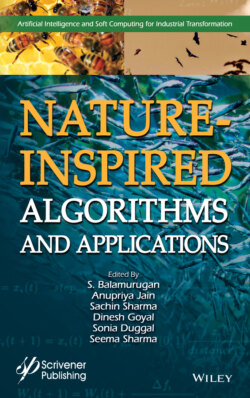Читать книгу Nature-Inspired Algorithms and Applications - Группа авторов - Страница 32
1.5.1.4.10 River Formation Dynamics
ОглавлениеRiver Formation Dynamic (RFD) is an optimization approach based on heuristic method on the behavior of manner in which the water is dropped from river bed. This mimicks how river water, by decomposition of the ground, saves the silt. The group of droplets that are placed at the beginning stage is exposed to force by gravitation that pulls in the drops to the focal point of the earth. The results of these drops are circulated all through their condition and looking for the absolute bottom in the ocean. Numerous new riverbeds are framed in the process right now. The RFD uses the idea behind the problems of graph theory. The group of drops by agents is made and proceeds onward edges between hubs that investigating a domain for the best arrangement. This is cultivated by components of disintegration and top soil sedimentation that identify with changes in the height that is consigned to every other hub. Drops while transferring to all through a situation of alter hub heights along their way. The change starting with one hub then onto the next is completed by diminishing height of the hubs, which in certainty gives numerous advantages like local cycles that are avoided. When drops change the site by minimum or maximum of the height of spots, the explanations are given by the path of height which is diminishing. Minimizing angles are constructed and the inclines are lag behind the consequent droplets as to create the fresh directions and strengthen the finest direction. This optimization of heuristic approach is introduced by Rabanalin 2007. RFD is utilized to solve TSP.
The working of RFD algorithm is as follows. A measure of soil is allotted to every hub. Drops, as they move, disintegrate their ways like taking some dirt from hubs or storing the conveyed dregs, which is referred, in this way, as expanding the elevations of hubs. Probability of selecting the following hub relies upon the slope which is corresponding to the contrast between tallness of the hub at which the drop lives and stature of its neighbor. Initially, the earth is level, for example, heights of all centers are corresponding, and aside from the objective center which is equivalent to zero during the whole procedure. Drops are put in the underlying center to empower further investigation of the earth. At each stage, a gathering of drops consecutively navigates the space and afterward performs disintegration on visited hubs [11].
The RFD algorithm has some disadvantages which avoid the algorithm for great execution, termed as problem of path generation. On account of an enormous number of coefficients, tuning of the algorithm to a specific case which is unintuitive in high case and regardless of its rate of convergence is little for increasingly confused situations.
